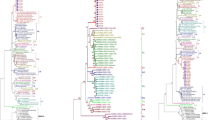Abstract
Pestiviruses are enveloped viruses of the Flaviviridae family, which have a highly variable genome, which is represented by a single-stranded (+) RNA with a size of ≈12.3 thousand of nucleotide sequences (1). The genus Pestivirus includes the established species Bovine Diarrhea Virus (BVDV) –1, BVDV-2, Borderline Disease Virus (BDV) and Classical Swine Fever Virus (CSFV), as well as a growing number of additional suspected Pestivirus species. Bovine viral diarrhea virus is widespread in many countries of the world. The economic damage is significant: the shortage of offspring due to abortion, stillbirth, treatment costs, identification of persistently infected animals and prevention, especially among young livestock. One of the methods of disease diagnostics is the method of virus isolation in cell culture. The paper presents the results of the study of biological properties of the reference viral diarrhea virus Oregon 24 and Ressa isolate of cattle identified as the first type. Viruses were cultured in continuous cell cultures PT-80, LEK, KST, Taurus-1 (T-1) for 5 passages. Virus titers were counted in every 5th passage, which ranged from 5.5–5.75 lg TCID50/0.1 ml for PT-80, KST, Taurus-1 cell cultures, for the continuous LEK line from 3.00 to 4.75 lg TCID50/0.1 ml.
Access this chapter
Tax calculation will be finalised at checkout
Purchases are for personal use only
Similar content being viewed by others
References
Tuncer-Göktuna, P., Yesilbag, K.: Evaluation of diagnostic methods for the detection of pestiviruses in clinical samples. Turkish J. Vet. Anim. Sci. 41, 175–179 (2017). https://doi.org/10.3906/vet-1602-8
Collett, M.S., Anderson, D.K., Retzel, E.: Comparisons of the pestivirus bovine viral diarrhea virus with members of the flaviviridae. J. Gen. Virol. 69(Pt10), 2637–2643 (1988). https://doi.org/10.1099/0022-1317-69-10-2637. PMID: 2844971
Houe, H.: Epidemiological features and economical importance of bovine virus diarrhoea virus (BVDV) infections. Vet. Microbiol. 64(2–3), 89–107 (1999). https://doi.org/10.1016/s0378-1135(98)00262-4
Lamp, B., Schwarz, L., Högler, S., Riedel, C., Sinn, L., Rebel-Bauder, B., et al.: Novel Pestivirus Species in Pigs, Austria, 2015. Emerg. Infect. Dis. 23(7), 1176–1179 (2017). https://doi.org/10.3201/eid2307.170163
Glotov, A.G., Glotova, T.I.: Atypical pestiviruses of cattle. Agricult. Biol. 50(4), 399–408 (2015). https://doi.org/10.15389/agrobiology.2015.4.399rus
Postel, A., Schmeiser, S., Oguzoglu, T.C., et al.: Close relationship of ruminant pestiviruses and classical Swine Fever virus. Emerg. Infect. Dis. 21(4), 668–672 (2015). https://doi.org/10.3201/eid2104.141441
Jenckel, M., Höper, D., Schirrmeier, H., et al.: Mixed Triple: Allied Viruses in Unique Recent Isolates of Highly Virulent Type 2 Bovine Viral Diarrhea Virus Detected by Deep Sequencing. J. Vir. Mayol. 88(12), 6983–6992 (2014). https://doi.org/10.1128/JVI.00620-14
Lanyon, S.R., Reichel, M.P.: Understanding the impact and control of bovine viral diarrhoea in cattle populations. Springer Sci. Rev. 1(1–2), 85–93 (2013). https://doi.org/10.1007/s40362-013-0007-6
Daniel, L.G.: Reproductive consequences of infection with bovine viral diarrhea virus. Vet. Clin. North Am.: Food Anim. Pract. 20(1), 5–19 (2004). https://doi.org/10.1016/j.cvfa.2003.11.006
Hou, P., Zhao, G., Wang, H.: The prevalence of bovine viral diarrhea virus in dairy cattle herds in eastern China. Trop. Anim. Health Prod. 51, 791–798 (2019). https://doi.org/10.1007/s11250-018-1751-z
Yeşilbağ, K., Alpay, G., Becher, P.: Variability and global distribution of subgenotypes of bovine viral diarrhea virus. Viruses 9(6), 128 (2017). https://doi.org/10.3390/v9060128
Ochirkhuu, N., et al.: Molecular detection and characterization of bovine viral diarrhea virus in Mongolian cattle and yaks. Arch. Virol. 161(8), 2279–2283 (2016). https://doi.org/10.1007/s00705-016-2890-z. Epub 2016 May 20 PMID: 27206573
Krasochko, P.A., Krasochko, I.A., Kashpar, L.N., et al.: Assessment of the infectious activity of calf pneumoenteritis pathogens. Collection of scientific papers. KRIA DPO FGBOU VO Kuban GAU; OOO “Publishing House-YUG” Krasnodar, pp. 179–182 (2019)
Mishchenko, V.A., Korpusova, T.I., Dymova, V.V.: Optimization of cultivation conditions for cattle viruses in continuous cell cultures. F - Veterinary 2, 60–63 (2014)
Electronic Fund of Legal and Normative-Technical Documents: Website. Text: Electronic. https://docs.cntd.ru/document/1200137605. Access 27 April 2021
Dubanevich, O.V.: Isolation and cultivation of viral diarrhea virus in cattle. F-Epizootol. Immunobiol. Pharmacol. Sanitat. 3, 29–36 (2016)
Author information
Authors and Affiliations
Editor information
Editors and Affiliations
Rights and permissions
Copyright information
© 2022 The Author(s), under exclusive license to Springer Nature Switzerland AG
About this paper
Cite this paper
Skvortsova, A., Mikhailova, V., Shishkina, M., Lobova, T. (2022). Cultivation of Viral Diarrhea Virus in Continuous Cell Cultures and Assessment of Its Infectious Activity. In: Muratov, A., Ignateva, S. (eds) Fundamental and Applied Scientific Research in the Development of Agriculture in the Far East (AFE-2021). AFE 2021. Lecture Notes in Networks and Systems, vol 354. Springer, Cham. https://doi.org/10.1007/978-3-030-91405-9_8
Download citation
DOI: https://doi.org/10.1007/978-3-030-91405-9_8
Published:
Publisher Name: Springer, Cham
Print ISBN: 978-3-030-91404-2
Online ISBN: 978-3-030-91405-9
eBook Packages: Intelligent Technologies and RoboticsIntelligent Technologies and Robotics (R0)




